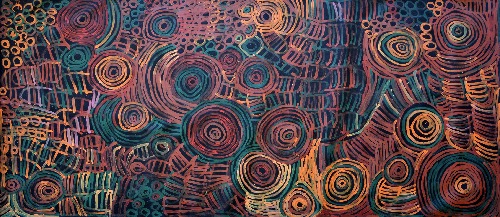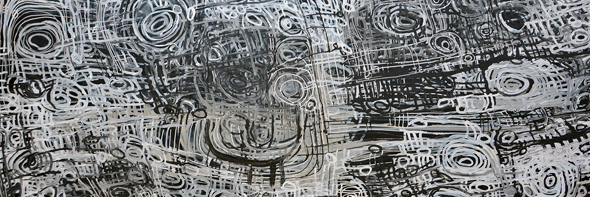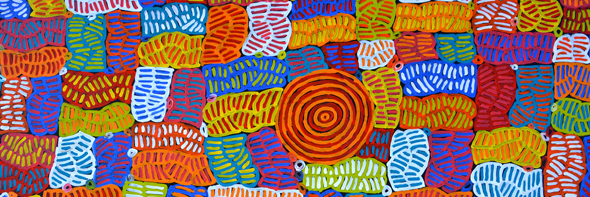Awelye, Body Paint
An Introduction, Awelye Represented in Paintings
& An Exclusive Interview with Charmaine Pwerle
Introduction
Awelye refers to women’s ceremonies associated with women’s business and also refers to the painting of designs on a woman’s body. Awelye makes connections with the fertility of the land and a celebration of the food it provides. It is performed by Aboriginal women from the Utopia region to recall their ancestors, to show respect for their country and to demonstrate their responsibility for the wellbeing of their community.
Awelye ceremonies begin with the women painting each other’s bodies in designs relating to a particular woman’s Dreaming and in accordance with their skin name. The Awelye designs represent a range of Dreamings including animals and plants, healing and law.
In what has been described as a sensuous and meditative performance, the designs are painted on the upper breast, chest and arms using powders ground from ochre, charcoal and ash. It is applied in raw linear and curved lines, while the women sing Dreaming songs of Ancestral figures and activities. The final part of the ceremony is when the women assiduously perform dance cycles specific to site. In many cases, the preparation of the body for these dances take much longer than the performance.
Awelye Represented in Paintings
Minnie Pwerle (c1910– 2006) was an Anmatyerre/Alyawarre woman and her Country was Atnwengerrp in the Utopia region of central Australia. Minnie became, along with her contemporary, Emily Kame Kngwarreye, one of Australia's greatest female Aboriginal artists. Despite only beginning her painting career in her mid 70s, the source and great inspiration for her art came from her lifetime involvement in traditional Aboriginal ceremonial practice and rituals, where she was responsible for applying the all-important body paint designs to participants in women's ceremonies.

Minnie Pwerle - Awelye Atnwengerrp
Minnie painted two series of artworks: ‘Bush Melon’ or ‘Bush Melon Seed’ which depicted her Dreamings, and ‘Awelye Atnwengerrp’. The latter represents the ochre designs painted on the top half of women’s bodies for Awelye. On canvas, as in ceremony, Minnie painted mesmerizing lines and circles; her U-shapes depict women’s painted breasts. The lively rhythms celebrate and capture the energy and movements of women dancing and singing.
Minnie’s daughter, Betty Mbitjana (and sister of Barbara Weir), depicts Awelye and Bush Melon in her paintings and employs a bright, multicoloured palette which give the artworks a lovely sense of joy; they have a very uplifting effect in any area where they hang. Occasionally there will be patterns of the seeds and the bush plums the women eat at the ceremony; Betty has fond memories of her mother and other women collecting these fruits, cutting them up into pieces, skewering them on a piece of wood and dry them to be eaten in times when bush tucker was scarce.
Like the natural progression of a new generation, Charmaine Pwerle’s artworks have taken the next step from her grandmother Minnie’s paintings, adding layers of complexity and movement. In a way, Charmaine’s work shows that nothing in their vibrant culture is static and as thing progress, evolve and move forward with time, the ancient and ceremonial traditions that her Awelye paintings pay homage to will not be lost.

Exclusive Interview with Charmaine Pwerle
We were lucky enough to have Charmaine Pwerle visit the gallery and provide more information about her art and Awelye Dreaming. The series of interviews below reveal interesting aspects of the Awelye ceremony and an exclusive insight into the deeper meanings of Charmaine’s art – a ‘must-see’ for art lovers!
Episode 1: Charmaine gives an explanation of her artwork Awelye, featured in a recent exhibition at Kate Owen Gallery
Episode 2: Charmaine delicately explains the deeper meanings of her Dreaming ‘Awelye’
Episode 3: “It’s a lot more than Awelye”
Episode 4: The use layers in Charmaine Pwerle’s art
Episode 5: The stages of Charmaine Pwerle’s Art Practice
Related Topics:
Body Paint and Ceremonial Artifacts
Art from the Utopia Region

